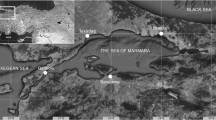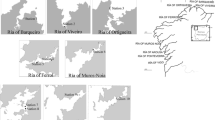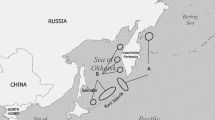Abstract
Blue mussels (Mytilus edulis) and Pacific oysters (Crassostrea gigas) collected at seven locations in the Lower Saxonian Wadden Sea in January and February 2007 were analysed for organochlorine compounds. Contaminants were present in all samples, albeit with variable amounts and composition. The highest values were found in the Jade Bay. Congener PCB 153 was the contaminant which had the highest content of all organochlorines tested (475.75–937.39 ng/g lipid). DDT was detected in one sample only while DDD and DDE were found in all samples, the latter with contents up to 351.34 ng/g lipid. No clear differentiation could be made in terms of accumulation of organochlorines for M. edulis and C. gigas. Comparison with data from 2001 to 2006 showed an increase in 2007, which may be due to the different season the samples were taken.





Similar content being viewed by others
Notes
Excel, Microsoft Office 2000.
References
Baršienė J, Lehtonen KK, Koehler A, Broeg K, Vuorinen PJ, Lang T, Pempkowiak J, Šyvokienė J, Dedonyte V, Rybakowas A, Repečka R, Vuontisjärvi H, Kopecka J (2006) Biomarker response in flounder (Platichthys flesus) and mussel (Mytilus edulis) in the Klaipėda-Būtingė area (Baltic Sea). Mar Pollut Bull 53:422–436
Beard M, Marshall S, Jong K, Newto R, McBride TT, Humphries B, Bronks R (2000) 1,1,1-Trichloro-2,2-bis-(p-chlorophenyl)-ethane (DDT) and reduced bone mineral density. Arch Environ Health 55(3):177–180
Cheevaporn V, Duangkaew K, Tangkrock-Olan N (2005) Environmental occurrence of organochlorines in the East Coast of Thailand. J Health Sci 51:80–88
Damm U, Neudecker T (2006) Zweikampf im Wattenmeer. Wird die heimische Miesmuschel verdrängt? Inf. Fischereiforsch 53:46–48
Deslous-Paoli J-M, Héral M (1988) Biochemical composition and energy value of Crassostrea gigas (Thunberg) cultured in the bay of Marennes-Oléron. Aquat Living Resour 1:239–299
DeVoogt P, Wells DE, Reutergårdh L, Brinkman UATh (1990) Biological activity, determination and occurrence of planar, mono- and di-ortho PCBs. Int J Environ Anal Chem 40:1–46
Gladen BC, Klebanoff MA, Hediger ML, Katz SH, Barr DB, Davis MD, Longnecker MP (2004) Prenatal DDT Exposure in relation to anthropometric and pubertal measures in adolescent males. Environ Health Perspect 112(17):1761
Götschenberg A, Schlüter V (2005) Monitoring von Baggergut-Verklappungen auf der Klappstelle „Vareler Fahrwasser” im Jadebusen, Zwischen Weser und Ems, Hydrographie-Vermessung mit Tiefgang. In: Beiträge zum 20. Hydrographentag und 64. DVW-Seminar 2005 in Wilhelmshaven, Schriftreihe des DVW, Band 47, Wißmar-Verlag, Augsburg, pp 44–55
Gribble GW (1998) Naturally occurring organohalogen compounds. Acc Chem Res 31:141–152
Gribble GW (ed) (2003) Natural production of organohalogen compounds. The handbook of environmental chemistry Part P. Springer, Berlin, p 312
Ilyina T (2007) The fate of persistent organic pollutants in the North Sea: multiple year model simulations of γ-HCH, α-HCH and PCB 153. Hambg Stud Marit Aff 7:132
Lee CL, Chen HY, Chuang MY (1996) Use of oyster, Crassostrea gigas, and ambient water to assess metal pollution status of the charting coastal area, Taiwan, after the 1986 green oyster incident. Chemosphere 33(12):2505–2532
Okumura Y, Yamishita Y, Isagawa S (2003) Sources of polychlorinated dibenzo-p-dioxins (PCDDs), polychlorinated dibenzofurans (PCDFs), and coplanar polychlorinated biphenyls (Co-PCBs), and their bioaccumulation through the marine food web in Sendai Bay, Japan. J Environ Monit 5:610–618
Oslo-Paris-Commission (2006) 2005/2006 CEMP Assessment—Trends and concentrations of selected hazardous substances in the marine environment, p 39. http://www.ospar.org
Pazikowska G, Szaniawska A (1988) Variations in energy and lipid content of Mytilus edulis from the Gulf of Gdansk. Oceanologia 25:99–107
Potrykus J, Albalat A, Pempkowiak J, Porte C (2003) Content and pattern of organic pollutants (PAHs, PCBs and DDT) in blue mussels (Mytilus edulis) from the southern Baltic Sea. Oceanologia 45:337–355
Schmidt CW (2001) Of POPs and the river-Environmentalists claimed victory when EPA approved dredging the Hudson River to remove polychlorinated biphenyls. But will the cleanup operations reduce exposure of humans to PCBs or not? Chem Innov 31:48–52
Sheridan PF (1975) Uptake, metabolism and distribution of DDT in organs of the Blue Crab Callinectes sapidus. Chesap Sci 16(1):20–26
Solé M, Porte C, Barcelo D, Albaiges J (2000) Bivalves residue analysis for the assessment of coastal pollution in the Ebro Delta (NW Mediterranean). Mar Poll Bull 40:746–753
Wehrmann A, Markert A, May P, Schieck P, Schmidt A (2006) Gefährdungspotential der eulitoralen Miesmuschelbänke im Niedersächsischen Wattenmeer durch die Bioinvasion der Pazifischen Auster (Crassostrea gigas). Abschlussbericht Projekt 7/02 der Niedersächsischen Wattenmeer-Stiftung, 110 pp
Wintermyer ML, Cooper KR (2003) Dioxin/furan and polychlorinated biphenyl concentrations in Eastern Oyster (Crassostrea virginica, Gmelin) tissues and the effect on egg fertilisation and development. J Shellfish Res 22(3):737–746
Witczak A, Leszczyńska A (2006) Polychlorinated biphenyl (PCB) congener residues in frutti di mare (seafood) products. Acta Sci Pol, Technol Aliment 5(2):117–126
Acknowledgement
We are indebted to the Niedersächsisches Landesamt für Wasser, Küsten und Naturschutz for the permision to use their unpublished data. Uwe Walter, Mytilamar, and Gerald Millat, National Park Administration, provided the 2004 and 2006 samples. Furthermore we would like to thank Ursula Pijanowska and Daniela Brehpohl for beeing a great help performing this research and Dorothea Bender for having the patience reading and correcting this work.
Author information
Authors and Affiliations
Corresponding author
Rights and permissions
About this article
Cite this article
Dörr, B., Liebezeit, G. Organochlorine Compounds in Blue Mussels, Mytilus edulis, and Pacific Oysters, Crassostrea gigas, from Seven Sites in the Lower Saxonian Wadden Sea, Southern North Sea. Bull Environ Contam Toxicol 83, 874–879 (2009). https://doi.org/10.1007/s00128-009-9825-2
Received:
Accepted:
Published:
Issue Date:
DOI: https://doi.org/10.1007/s00128-009-9825-2




